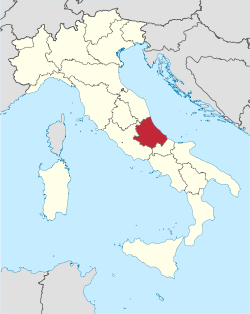This article may require copy editing for grammar, style, cohesion, tone, or spelling. (April 2024) |
Abruzzo
Abruzzi | |
|---|---|
|
| |
 | |
| Country | |
| Capital | L'Aquila |
| Largest city | Pescara |
| Government | |
| • President | Marco Marsilio (FdI) |
| Area | |
| • Total | 10,763 km2 (4,156 sq mi) |
| Highest elevation | 2,914 m (9,560 ft) |
| Population (2020) | |
| • Total | 1,305,770 |
| • Density | 120/km2 (310/sq mi) |
| Demonym | Italian: Abruzzese |
| GDP | |
| • Total | €32.889 billion (2021) |
| Time zone | UTC+1 (CET) |
| • Summer (DST) | UTC+2 (CEST) |
| ISO 3166 code | IT-65 |
| HDI (2021) | 0.892[2] very high · 13th of 21 |
| NUTS Region | ITF |
| Website | https://www.regione.abruzzo.it/ |
Abruzzo (US: /ɑːˈbruːtsoʊ, əˈ-/,[3][4] UK: /æˈbrʊtsoʊ/;[5] Italian: [aˈbruttso]; Abruzzese Neapolitan: Abbrùzze [abˈbruttsə], Abbrìzze [abˈbrittsə] or Abbrèzze [abˈbrɛttsə]; Aquilano: Abbrùzzu), historically known as Abruzzi, is a region of Southern Italy with an area of 10,763 square km (4,156 sq mi) and a population of 1.3 million. It is divided into four provinces: L'Aquila, Teramo, Pescara, and Chieti. Its western border lies 80 km (50 mi) east of Rome. Abruzzo borders the region of Marche to the north, Lazio to the west and north-west, Molise to the south and the Adriatic Sea to the east. Geographically, Abruzzo is divided into a mountainous area in the west, which includes the highest massifs of the Apennines, such as the Gran Sasso d'Italia and the Maiella, and a coastal area in the east with beaches on the Adriatic Sea.
Abruzzo is considered a region of Southern Italy in terms of its culture, language, economy, and history, though in terms of physical geography, it may also be considered part of Central Italy.[6] The Italian Statistical Authority (ISTAT) deems it to be part of Southern Italy, partly because of Abruzzo's historic association with the Kingdom of the Two Sicilies.[6]
Almost half of the region's territory is protected through national parks and nature reserves, more than any administrative region on the continent, leading it to be dubbed "the greenest region in Europe."[7][8] There are three national parks, one regional park, and 38 protected nature reserves. These ensure the survival of rare species, such as the golden eagle, the Abruzzo (or Abruzzese) chamois, the Apennine wolf and the Marsican brown bear.[9] Abruzzo's parks and reserves host 75% of Europe's animal species.[8] The region is also home to Calderone, one of Europe's southernmost glaciers.[10]
Nineteenth-century Italian diplomat and journalist Primo Levi (1853–1917) chose the adjectives forte e gentile ("strong and kind") to capture what he saw as the character of the region and its people. "Forte e gentile" has since become the motto of the region.[11]
- ^ "Population on 1 January by age, sex and NUTS 2 region", www.ec.europa.eu, archived from the original on 25 December 2023, retrieved 29 December 2023
- ^ "Sub-national HDI – Area Database – Global Data Lab". hdi.globaldatalab.org. Archived from the original on 23 September 2018. Retrieved 5 March 2023.
- ^ "Abruzzo". The American Heritage Dictionary of the English Language (5th ed.). HarperCollins. Retrieved 6 May 2019.
- ^ "Abruzzi". Merriam-Webster.com Dictionary. Merriam-Webster. Retrieved 6 May 2019.
- ^ "Abruzzi". Lexico UK English Dictionary. Oxford University Press. Archived from the original on 22 March 2020.
- ^ a b Paradosso evidenziato da Ignazio Silone, cfr. Costantino Felice (2010). "Quadri ambientali e identità regionale". In Donzelli (ed.). Le trappole dell'identità: l'Abruzzo, le catastrofi, l'Italia di oggi. Rome: Donzelli. p. 41. ISBN 978-88-6036-436-4.[permanent dead link]
- ^ "The spectacular region of Italy you've probably never heard of". Independent.co.uk. 26 July 2017. Archived from the original on 12 November 2020.
- ^ a b "L'Abruzzo Regione Verde d'Europa". Laquilacapitale (in Italian). Archived from the original on 15 February 2015.
- ^ "Fauna | Parco Nazionale d'Abruzzo, Lazio e Molise". www.parcoabruzzo.it. Archived from the original on 27 November 2013. Retrieved 27 November 2013.
- ^ "I parchi in Abruzzo". www.abruzzoverdeblu.it. Archived from the original on 2 December 2013. Retrieved 27 November 2013.
- ^ "Abruzzo: Forte e Gentile, definizione di Primo Levi, giornalista e diplomatico, nel sito di vastospa". Archived from the original on 2 September 2012.

